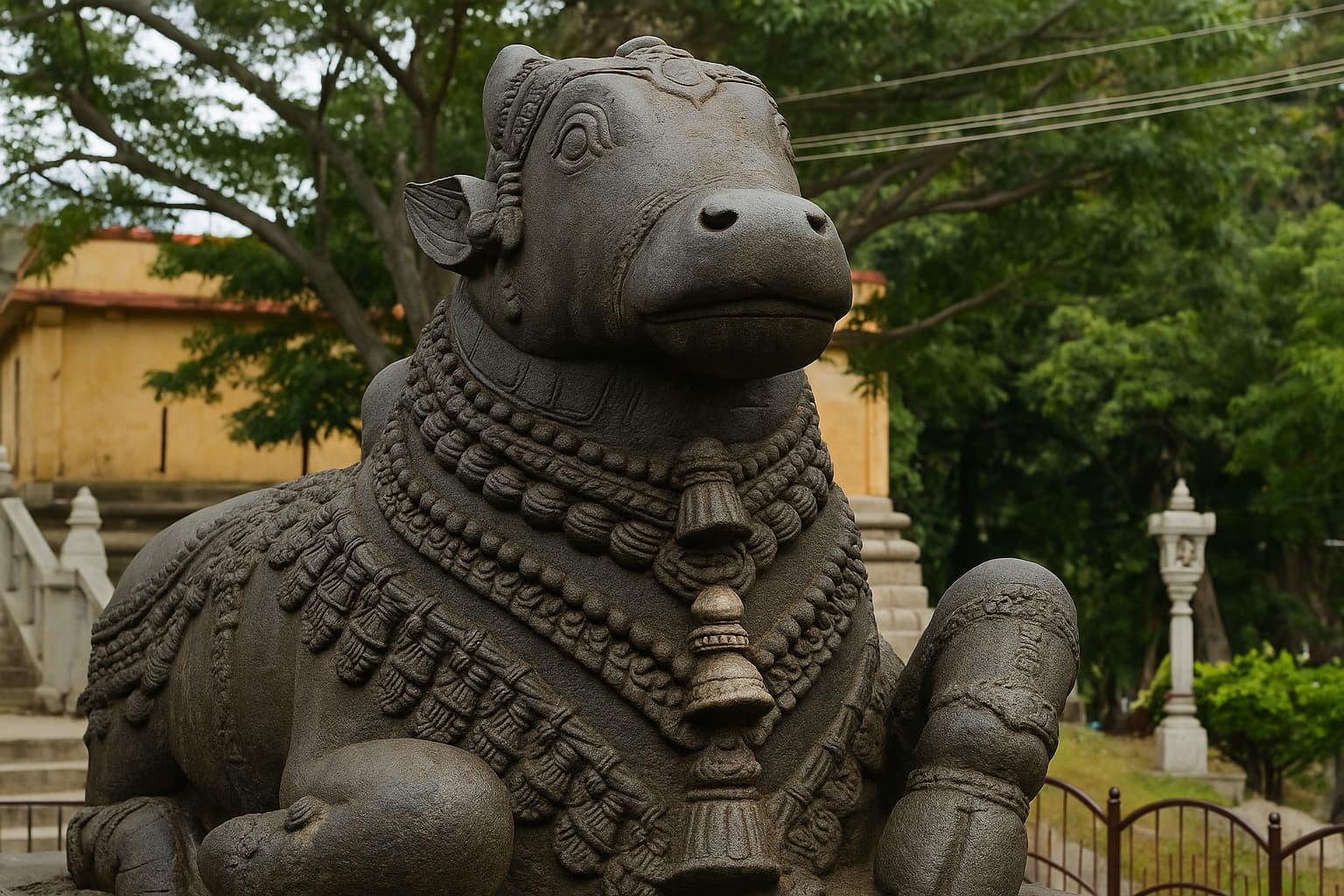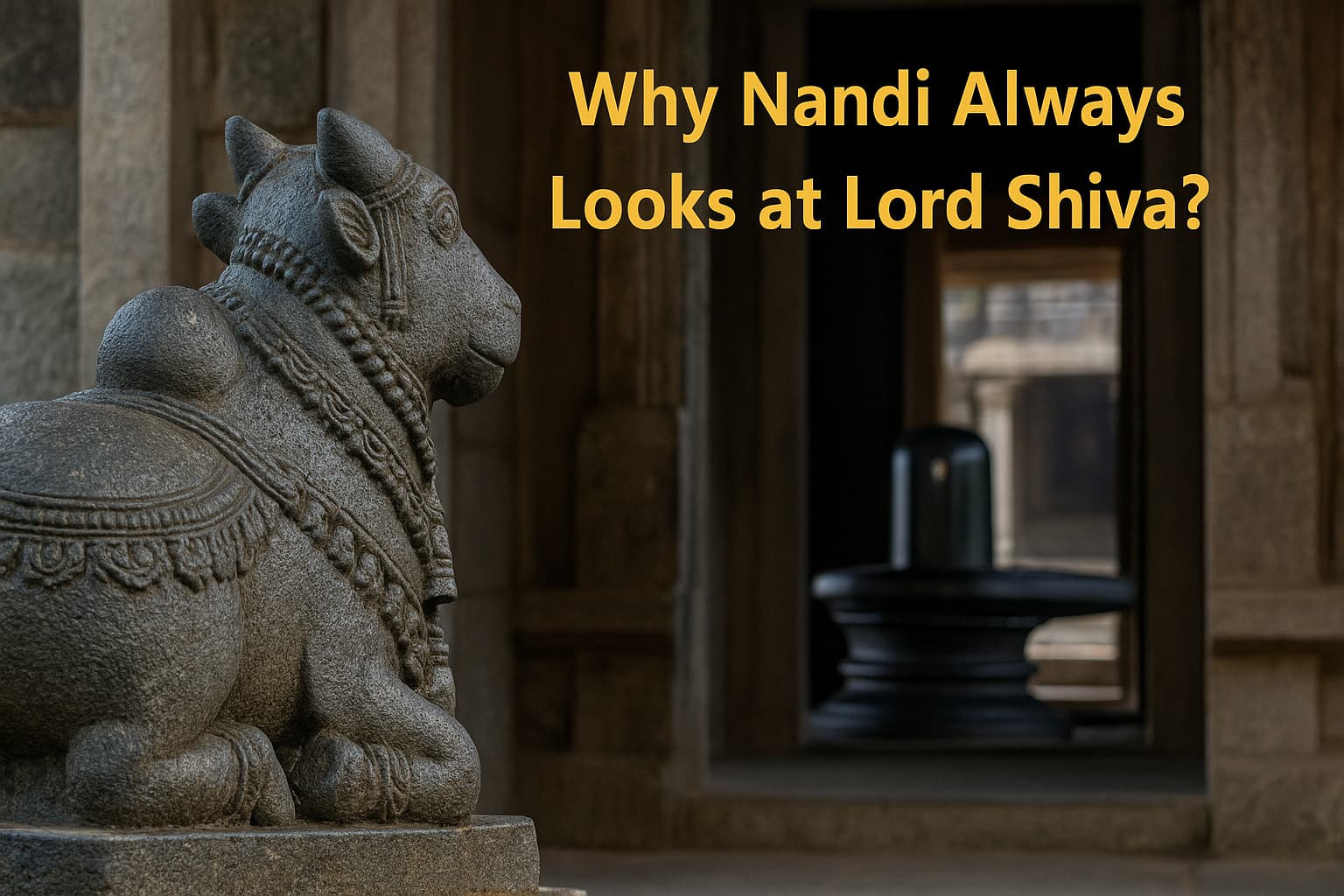Why Nandi faces the Linga is a question deeply rooted in temple traditions and spiritual symbolism. In almost every Shiva temple, there’s a sight both familiar and sacred — the grand figure of Nandi, the bull, seated opposite the Shivalinga, eyes fixed with unwavering devotion. This powerful alignment is more than architectural—it carries layers of meaning about faith, silence, and surrender.
For example, in the Mahabaleshwar Temple of Gokarna, Nandi sits directly in front of the Atmalinga, forming a perfect spiritual axis that guides devotees’ gaze toward Lord Shiva. But why is this sacred placement followed across almost all Shiva temples, especially in Karnataka? Let’s unravel the mystery behind Nandi’s unique position in these holy spaces.
More Than a Bull: Who Is Nandi in Shaiva Tradition?
To many, Nandi might appear as just a bull statue in front of Shiva temples — but he holds far deeper significance. In Shaiva tradition, Nandi is not only the vahana (divine vehicle) of Lord Shiva but also his chief devotee, disciple, and spiritual gatekeeper. He is said to guard the entrance to Shiva’s divine abode, Kailasa, and is the first among Shiva’s followers, known as the ganas.
Nandi represents more than loyalty — he symbolizes discipline, focus, and silent devotion. His seated posture in front of the Shivalinga is no coincidence; it’s a sacred placement full of spiritual meaning.
A powerful example of Nandi’s revered status can be seen at Dodda Basavana Gudi, also known as the Bull Temple, in Bangalore. It houses one of the largest Nandi statues in India, carved from a single granite rock. Though there’s no visible linga inside the temple, the presence of the massive Nandi itself draws thousands of devotees, showing how significant Nandi is in Shaiva worship.
Let’s now explore why his position in front of the linga is so spiritually important.

More Than a Bull: Who Is Nandi in Shaiva Tradition?
To many, Nandi might appear as just a bull statue in front of Shiva temples — but he holds far deeper significance. In Shaiva tradition, Nandi is not only the vahana (divine vehicle) of Lord Shiva but also his chief devotee, disciple, and spiritual gatekeeper. He is said to guard the entrance to Shiva’s divine abode, Kailasa, and is the first among Shiva’s followers, known as the ganas.
Nandi represents more than loyalty — he symbolizes discipline, focus, and silent devotion. His seated posture in front of the Shivalinga is no coincidence; it’s a sacred placement full of spiritual meaning.
A powerful example of Nandi’s revered status can be seen at Dodda Basavana Gudi, also known as the Bull Temple, in Bangalore. It houses one of the largest Nandi statues in India, carved from a single granite rock. Though there’s no visible linga inside the temple, the presence of the massive Nandi itself draws thousands of devotees, showing how significant Nandi is in Shaiva worship.
Let’s now explore why his position in front of the linga is so spiritually important.
Spiritual Symbolism: Devotion Without Distraction
Nandi’s unchanging position — seated directly opposite the Shivalinga — symbolizes more than tradition; it reflects the ideal relationship between a devotee and the Divine. His folded legs, calm gaze, and silent posture convey absolute concentration and unwavering devotion. In Hindu philosophy, this represents the perfect way to approach God: with stillness, humility, and inner silence. Nandi doesn’t turn away, doesn’t speak — he simply watches Shiva with full awareness, teaching us that spiritual connection requires focus without distraction, presence without pride, and devotion without demands. This sacred alignment is believed to guide devotees to look through Nandi toward the linga, allowing their worship to pass through a filter of pure bhakti (devotion), making it more spiritually potent.
Sacred Geometry: The Divine Alignment in Temples
In Shaiva temple architecture, there is a sacred concept called Garbhagriha Patha — an invisible energy line that connects the temple entrance, Nandi, and the Shivalinga inside the sanctum. This alignment is believed to direct both physical sight and spiritual energy toward Lord Shiva.
At the Mahabaleshwar Temple in Gokarna, Nandi is perfectly positioned in front of the Atmalinga, allowing devotees to have an unbroken visual and spiritual connection through his gaze.
In Nanjundeshwara Temple at Nanjangud, the same divine layout is followed, helping devotees align their thoughts with focused devotion by looking at Shiva through Nandi’s watchful eyes.
This sacred placement is not just tradition or design — it symbolizes how spiritual darshan must pass through devotion (Nandi) before reaching the Divine (Shiva).
A Message in Silence: Why Nandi Doesn’t Speak
In Shaiva tradition, Nandi is seen as the embodiment of silence, or mauna, and his silent gaze toward the Shivalinga speaks volumes about inner devotion. With his calm posture and sealed lips, Nandi teaches that true bhakti doesn’t need loud expressions — it needs presence, focus, and surrender. His silence is not emptiness but deep awareness. Even today, in many temples across Karnataka and beyond, devotees softly whisper their wishes into Nandi’s ears, trusting that this ever-watchful devotee will pass them on to Lord Shiva. This simple act reflects a powerful spiritual truth: when our minds are still and undistracted — just like Nandi — we become better vessels to connect with the divine.
Read more: How Many Times Should a Temple Bell Be Rung? – Explore the deeper meaning behind temple bell ringing and how it connects to spiritual focus.
Nandi Across India: Sacred Temples and Local Beliefs
The sacred positioning of Nandi facing the Shivalinga is not limited to Karnataka — it’s a pan-India tradition rooted in deep symbolism and temple architecture. From North to South, each temple has its own story, local belief, or myth surrounding Nandi’s watchful gaze.
Whether carved from a single rock or placed on a hilltop, Nandi’s alignment with Shiva represents unwavering devotion and spiritual focus. Below is a curated list of famous temples.
| Temple Name | Location | Nandi’s Believed Role or Position |
|---|---|---|
| Gokarna Mahabaleshwar Temple | Uttara Kannada, Karnataka | Nandi sits directly aligned with the Atmalinga, symbolizing purified vision before darshan. |
| Dodda Basavana Gudi (Bull Temple) | Bengaluru, Karnataka | Home to one of Asia’s largest Nandi statues, believed to spiritually watch over the city. |
| Nanjundeshwara Temple | Nanjangud, Karnataka | Nandi is placed in perfect alignment with the inner sanctum, guiding the devotee’s vision. |
| Kedarnath Temple | Uttarakhand | The ancient Nandi idol near the steps faces the sacred Jyotirlinga in silence and snow. |
| Brihadeeswarar Temple | Thanjavur, Tamil Nadu | Massive monolithic Nandi faces the towering Shiva lingam, symbolizing strength in devotion. |
| Kashi Vishwanath Temple | Varanasi, Uttar Pradesh | Nandi sits before the sanctum; devotees often whisper prayers in his ears to reach Shiva. |
| Omkareshwar Temple | Madhya Pradesh | Located on an island shaped like ‘Om’, Nandi faces Shiva’s linga along a sacred path. |
| Lingaraj Temple | Bhubaneswar, Odisha | Nandi is revered here as a separate shrine; always facing the linga in a meditative pose. |
A Lesson for Devotees: Be Like Nandi
In today’s fast-moving world, Nandi teaches us the power of stillness and silent devotion. He neither demands nor distracts—he simply sits with full presence, eyes fixed on Shiva. His calm, patient posture reminds us that true bhakti is about quiet focus and unwavering faith. Whether in prayer, meditation, or daily life, Nandi shows that devotion isn’t noise — it’s direction.
Mythology Adds Depth: A Story from the Puranas
One powerful explanation of why Nandi always faces the linga comes from a story in the Shiva Purana. According to the legend, Nandi was once entrusted with guarding the gates of Mount Kailasa, Lord Shiva’s divine abode. However, during his watch, an asura (demon) managed to slip past Nandi and disturb Shiva while he was deep in meditation. Realizing his mistake and feeling immense guilt, Nandi immediately begged for forgiveness.
As a mark of his repentance and renewed dedication, Nandi took a vow never to turn his gaze away from Lord Shiva again. Since then, it is believed that Nandi’s image is always placed facing the Shivalinga in temples — symbolizing eternal vigilance, loyalty, and focused devotion. This mythological story adds deep spiritual meaning to his position: Nandi doesn’t just look at Shiva — he watches over him, and inspires devotees to do the same.
Why Nandi’s Gaze Matters
So, why does Nandi face the Linga in every Shiva temple? It’s not just a matter of tradition — it’s a powerful symbol of unwavering devotion, spiritual discipline, and eternal focus. His gaze reminds us that reaching Shiva requires steadiness, silence, and surrender. Nandi doesn’t just sit there; he becomes a bridge between the devotee and the Divine — guiding the eyes, mind, and soul directly toward the linga. His position teaches us that to truly connect with Lord Shiva, we too must face the truth without turning away, just as Nandi does — with loyalty, humility, and inner stillness.
Curious about temple walks? Discover why we walk to the temple and how each step carries sacred symbolism rooted in ancient belief.
Learn more about Nandi’s role in Hinduism: Wikipedia – Nandi (Hinduism) offers a broader look at his mythological background and cultural significance across India.

